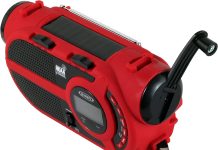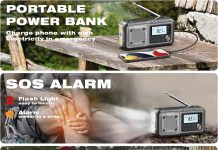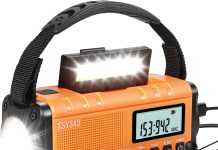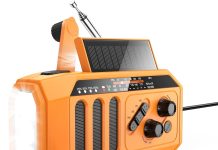Tornadoes are often one of the most destructive and life-threatening natural disasters. While they can strike without warning, there are some signs that a tornado is likely to occur.
Knowing these signs can be essential in ensuring your safety when you’re caught in the path of a tornado. This article will explore the critical warning signs of an impending twister so you know how to protect yourself and your loved ones.
The first sign that a tornado could be approaching is dark clouds forming quickly and moving in different directions at varying speeds.
Also, if thunder or hail is heard with no visible rain clouds, this may indicate a possible tornado formation. In addition to these atmospheric changes, winds can increase rapidly, often accompanied by a low rumbling sound similar to faraway train tracks.
Finally, it’s essential to look out for flying debris like leaves or branches being lifted from the ground and any large objects such as trampolines or outdoor furniture being moved around quickly by strong gusts of wind.
If any telltale warnings appear before a funnel cloud forms down from the sky – take cover immediately!
Review contents
Definition Of A Tornado
Tornadoes are some of the most destructive and deadly weather phenomena on Earth. A tornado is a violently rotating column of air that extends from a thunderstorm to the ground, sometimes forming huge funnel-shaped clouds.
Tornadoes come in different shapes and sizes, but all can cause massive destruction, with winds reaching up to 300 miles per hour.
Tornado definitions vary across scientific organizations; however, one standard classification system divides tornadoes into five categories based on their wind speed: F0 (weak), F1 (weak), F2 (strong), F3 (severe), and F4 (devastating).
Classifications are made according to the damage they cause, ranging from light damage, such as broken tree branches, to significant damage, like uprooting trees or destroying buildings.
The formation of a tornado begins when warm, humid air rises into cooler temperatures higher in the atmosphere; this causes instability which increases upward motion within storm clouds.
As these updrafts increase in strength, they become more concentrated, creating an area of rotation known as a mesocyclone. When this vital area of rotation reaches the surface, it forms what we know as a tornado.
No matter how powerful its winds may be, every tornado has warning signs before it occurs – darkening skies, large hail, and heavy rain followed by an eerie calmness or lull in activity.
The sudden stillness indicates that something big is about to happen – a dangerous twister spinning rapidly toward you at speeds exceeding 200 mph.
Potential Areas At Risk
Tornadoes can appear anywhere, but certain areas are more prone to them than others. Knowing where these tornado-risk areas are located can help keep people safe when a warning is issued.
Tornado hotspots in the United States include Alabama, Arkansas, Florida, Georgia, Illinois, Indiana, Iowa, Kansas, Louisiana, Mississippi, Missouri, and Nebraska. Those living in these states should be incredibly diligent in watching for signs of an impending tornado.
Outside of the United States, several other regions also experience frequent tornados. In central Europe, many countries have frequently seen tornados, including Austria, Germany, France, and Poland.
Areas around the Mediterranean Sea, such as Greece and Italy, also fall into this category. Further east into Asia, China and Japan both have high levels of tornado activity throughout the year, with some reports indicating hundreds or thousands of occurrences annually.
No matter where you live, it’s essential to know what type of weather conditions lead up to a potential tornado so that appropriate safety measures can be taken if necessary.
Paying attention to local news forecasts and being aware of any nearby danger zones may help provide valuable time for preparation before a storm arrives. Understanding how your region typically experiences severe storms will ensure everyone stays safe no matter what situation arises.
Weather Conditions That Could Lead To A Tornado
The conditions that could precede a tornado are so severe they seem almost impossible! The atmosphere is often full of tension and electricity as storm fronts approach.
Wind shear is not unusual to become extremely strong, with air pressure becoming very low. When these elements combine with high humidity levels, the risk of a tornado increases exponentially.
It’s important to note that tornadoes don’t just form out of nowhere- generally speaking, several distinct weather patterns must come into play concurrently for one to take shape. First, warm moist air must be present near the ground while colder dry air remains aloft, creating instability that encourages storms to form.
In addition, winds at various altitudes need to blow in different directions and have varying speeds- if they’re too similar, it can inhibit or even stop formation altogether.
Finally, something known as ‘convergence’ needs to occur: areas, where multiple bodies of air collide will cause an uplift, further strengthening the thunderstorm cloud associated with a potential tornado. If any part of this chain fails, the process may never get started in the first place!
It goes without saying – when all these pieces fit perfectly, you should proceed carefully… A powerful twister could be imminent!
Visual Indicators
The most common warning sign of a tornado is the appearance of specific clouds in the sky. These are known as “tornado clouds” and have a unique funnel shape, often extending from the base of a thunderstorm cloud.
Looking closely at these clouds, you may also see rotating debris around their lower part. Another visual indicator of an impending tornado is a darkening sky, which can sometimes take on a green tint. This indicates that hail or strong winds might be heading your way.
Lightning is another sign to watch out for – if it’s particularly frequent or intense, chances are there could be severe weather nearby. Keep an eye on the horizon, too; even if you don’t spot tornado clouds, other unusual activity such as large hail stones, fast-moving dust clouds, or loud noises might alert you to possible danger ahead.
In some cases, tornados can form suddenly with no signs whatsoever – so always stay vigilant when storms are forecasted in your area and pay attention to official warnings issued by local authorities.
Sound Warnings
Moving on from visual indicators, sound warnings are another essential way to detect a potential tornado.
Tornado sirens and audible alarms can give warning tones indicating a possible danger nearby. If you live in an area prone to tornadoes, it is wise to be familiar with the sound alerts indicating one is nearby.
Sound cues such as these should not be ignored; they serve as your first defense for staying safe during a tornado.
In addition to sounding off tornado sirens, local authorities often issue public safety announcements via TV or radio broadcasts when severe weather conditions occur. Alerts like these provide information about the location and severity of any upcoming storms, which can help people prepare accordingly.
Paying attention to this audio alert type is vital since it could save lives by providing more time for individuals to take shelter before the storm arrives.
Finally, understanding how certain sounds warn us of impending danger allows us to stay informed and remain vigilant against threats like tornadoes.
Keep up-to-date on all available sound alerts regarding inclement weather so you can react quickly if necessary. Be aware that tornado sirens and other warning tones exist for our protection – don’t hesitate to seek shelter if you hear them!
Early Warnings From Authorities
Early warnings from authorities are essential to staying safe during a tornado. Tornado alerts can be issued through weather forecasting services, local news outlets, and other emergency services.
Before any severe storm strikes, there is usually some warning or alert issued by the relevant authority.
These warnings can provide critical information about the severity of the upcoming storm and should always be taken seriously. For example, if a tornado watch has been issued in your area, you must know that conditions may quickly become dangerous.
A tornado warning is even more severe because it means one has already been detected on the radar or seen by someone nearby. In either case, taking shelter immediately is essential when a warning is issued for your area.
Stay informed about potential storms so you know what precautions to take before they arrive. Keep an eye on forecasts from official sources such as weather channels and emergency alerts from local authorities so you’re prepared when a tornado threatens your safety.
How To Prepare Your Home And Family
Preparing your home and family for a tornado is of utmost importance. Safety measures to protect yourself, your loved ones, and your property should be prioritized.
Ensuring you have all the necessary supplies can make the difference between life and death during a storm.
Begin by implementing safety measures in your home, such as securing outdoor furniture, trimming trees and shrubs, covering windows with shutters or plywood, anchoring gas tanks securely, and reinforcing doors and garage doors.
After that has been taken care of, stocking up on emergency storm supplies such as flashlights, batteries, non-perishable food items, water bottles, first aid kits, blankets, and extra clothes is essential.
It’s also essential to develop an emergency plan specifically designed for tornadoes with your family members so everyone knows what actions they need to take when severe weather hits.
This plan should include where to seek shelter if needed, either inside the house or outside in a designated safe area like under a bridge or overpass away from buildings; how each family member will communicate with one another if separated; who to contact in case of injury or disaster; and most importantly who is responsible for taking charge of decision making during times of distress.
Taking these proactive steps now will provide peace of mind knowing that you’re prepared for any potential danger caused by extreme storms.
Evacuation Plans
Evacuating from a tornado is like running away from an unstoppable force of nature. It can be incredibly frightening, but having an evacuation plan can give you and your family peace of mind during the storm.
Knowing where to go and how to get there safely should be a top priority when creating evacuation plans for your home and family.
Consider all possible evacuation routes that could lead your family to a haven, such as a neighbor’s house or local shelter, when making these plans. Remember to include alternative routes if primary ones become blocked due to debris or flooding. Additionally, consider building storm shelters or installing underground safe rooms to protect against tornadoes with higher intensities.
Creating emergency kits with essential items such as food, water, medications, flashlights, batteries, and first aid supplies that can last at least three days without access to power and other resources is vital.
Ensure everyone knows what items should be included in the kit and their designated roles in the event of an actual disaster. With these preparations taken care of beforehand, it will make evacuating much smoother and easier during unpredictable weather conditions.
Having detailed evacuation plans helps ensure everyone is familiarized with their responsibilities before facing them in real-life situations.
Doing this planning ahead gives people the confidence they need while facing potentially devastating storms so they know exactly what needs to be done once those warning signs appear on the horizon.
What To Do During The Storm
Once the warning signs of a tornado have been recognized, it is essential to prepare for the storm quickly.
Tornado preparation should include knowing what type of sheltering strategies are available in your area and preparing an emergency plan beforehand. It is also essential to prioritize family safety during these situations by seeking safe shelter from extreme weather conditions.
If there is no basement or underground shelter, consider finding a room on the lowest level of your building and away from windows. It’s also important to remember that mobile homes provide little protection against tornadoes. Hence, if you live in one, seek out alternative shelters such as community storm shelters or even sturdy buildings nearby with access to an interior hallway or bathroom.
Regardless of where you decide to take shelter, be sure that everyone knows exactly where they should go and how they can protect themselves while inside their chosen location until the tornado has passed.
Ensure all necessary items like food, water, medications, and other essentials are readily accessible before taking cover. Ensuring your family understands these measures will help keep them safe when severe storms strike.
When facing a potential tornado, an emergency plan could mean the difference between life and death.
Knowing what steps need to be taken beforehand can make a difference in times of crisis – so don’t wait until disaster strikes! Be proactive and create an actionable plan today; it may save your life tomorrow.
After The Tornado Passes By
The storm may have passed, but the tornado’s impact is still accurate. Like a stone thrown into a lake, the effects of tornadoes ripple outward and last far beyond their initial destruction.
After the tornado passes, homeowners must assess any property damage caused and contact insurance companies to pursue claims related to damages incurred from the storm. It is also essential for communities affected by tornadoes to come together to start rebuilding and recovery efforts.
In addition to physical cleanup efforts, ensuring that all citizens are educated on how to be prepared when severe weather strikes again are critical. This includes participating in community-wide drills that simulate real-life tornado scenarios so individuals can become familiar with what they should do if disaster strikes.
Furthermore, local governments must provide educational materials regarding safety protocols during storms and resources available post-tornado, including financial assistance programs or mental health services.
Rebuilding after a tornado takes time and effort from the entire community; however, by taking proactive steps towards preparing for future disasters and providing support within affected areas, citizens will be better equipped when faced with this type of natural disaster.
How To Help Those Affected By A Tornado
Helping those affected by a tornado is a crucial way to show support. There are many ways to offer assistance, from donating food and clothing to volunteering for relief efforts or providing shelter for the victims.
One of the best ways to provide aid is through donations. Organizations like Red Cross, Salvation Army, and other charities often need supplies to deliver necessary help during disasters.
Monetary contributions also make a difference; these funds can be used for essential items like medical care and vital housing repairs after a tornado strikes.
In addition to financial donations, it’s possible to lend physical support. Volunteering with organizations onsite helps with immediate needs while helping out at community shelters provides comfort and safety during recovery efforts. Participating in local fundraisers or donation drives geared towards tornado victims can give much-needed emotional support too.
No matter how you decide to contribute, offering assistance will go far in aiding those who tornadoes have impacted. With compassion and thoughtfulness comes hope – something every victim of natural disasters deserves.
Cleanup Aftermath
Now that we have discussed how to help those affected by a tornado, let’s focus on the aftermath of cleanup. After a tornado has passed through an area, extensive property damage and debris are often left behind.
Cleanup efforts should begin immediately following the storm. People must be safe while cleaning up after a tornado – wear protective clothing and avoid open power lines or other hazards.
Property owners should also ensure their insurance policies cover all possible damage caused by a tornado before beginning any repairs. The National Weather Service will provide detailed information about potential damages so individuals can take steps to minimize losses due to storm debris and wind damage.
When it comes time for the actual cleanup process, homeowners may need assistance removing fallen trees or branches from their property and repairing damaged roofs or siding on buildings.
Property owners should contact local government offices for more information on where to get help during the cleanup process. Once safety precautions have been taken, homeowners can start recovering from the destruction of a tornado and restoring their homes to normal.
Long-Term Impact Of Tornadoes
The destruction of a tornado can be devastating, and its long-term impact on survivors is often overlooked.
The aftermath of a tornado leaves behind property damage that can take months, if not years, to repair or replace. Survivor stories from people who have experienced tornadoes are filled with tales of physical and mental hardship.
Mental health care services are essential in the wake of a tornado as victims grapple with trauma, fear, shock, depression, and anxiety brought on by their experiences. Victims may also have PTSD due to the event or loss of loved ones.
Due to the many emotions felt after such an event, those affected must seek professional help to cope correctly and heal over time.
Recovery can be slow, but with proper support systems, individuals can rebuild their lives following a major storm like a tornado. Survivors should take things one step at a time while they work towards regaining their sense of security and peace again. With patience and resilience, we know these survivors will eventually come out more vital than ever before.
Educational Resources On Tornadoes
Educational resources on tornadoes can benefit those looking to learn more about these severe weather events.
Many available materials provide tornado safety information, facts, and other related topics.
For instance, the National Weather Service offers extensive educational materials on tornadoes, including brochures, videos, and interactive activities.
Additionally, many state governments have websites with detailed information regarding tornado safety and preparedness.
For those who prefer a hands-on approach to learning about tornadoes, universities, and other organizations offer numerous online courses.
These programs often include interactive simulations or field trips where participants can observe a confirmed tornado. Many of these courses even offer certification upon completion.
No matter what educational resource is chosen, it’s important to remember that knowledge is power when protecting oneself from this powerful force of nature.
With the proper education and preparation, people can better protect themselves during an emergency caused by a tornado.
Insurance Considerations For Property Damage
With the threat of a tornado looming, what can you do to protect your property? Insurance is essential when protecting yourself from potential damage caused by tornadoes.
This section will cover some vital insurance considerations and related information that homeowners should remember.
First off, how much coverage should you obtain for tornado-related property damage? Homeowners should consider purchasing additional coverage beyond their standard homeowner’s policy to ensure adequate protection against losses due to a tornado.
Generally, most policies won’t provide enough coverage without an additional endorsement or rider. It’s also important to factor in any deductible costs required under the policy so you know them before filing any claims after a storm hits.
Insurance companies may differ in the damages they will cover regarding tornado-caused destruction. Ensure you understand precisely what types of damages are covered by your particular policy beforehand – otherwise, you might find yourself on the hook for repair costs down the line!
Additionally, if any restrictions are associated with filing a claim or collecting benefits following a storm event, ensure that these terms and conditions are fully understood before purchasing your insurance coverage.
In short, it pays to be prepared to deal with possible property damage from a tornado strike. Before signing up for any insurance plan, review all relevant aspects, including deductibles and other applicable provisions, such as exclusions or limits on certain damages that may not be covered under your particular plan.
Doing so can help give you peace of mind knowing that whatever happens during severe weather events like tornadoes, at least your home will be adequately protected financially.
Frequently Asked Questions
How Long Do Tornadoes Typically Last?
When it comes to tornadoes, one of the primary questions people have is how long they last. Tornadoes can range in duration from a few seconds to over an hour, and their lifespan varies greatly depending on several factors.
This article will explore tornado duration, exploring what affects its longevity, as well as looking at the typical lengths of time that these powerful storms remain active.
Numerous variables determine the length of a tornado’s life cycle. Location, size, intensity, and environmental conditions all play a role in determining just how long a particular twister will stay alive. For example, suppose a tornado occurs near large bodies of water or high terrain features such as mountains. In that case, it may dissipate more quickly due to turbulent air currents being generated by those obstacles.
Additionally, more extensive and robust tornados tend to linger longer than smaller ones. Knowing this information can help us better predict when dangerous weather may be headed our way so we can take appropriate safety measures before it strikes.
On average, most tornadoes only last 10-20 minutes, but some have been known to last up to 1 hour or more in rare cases. It’s important to remember that no two tornadoes are alike; therefore, predicting how long any storm might linger can be difficult without specific meteorological data points.
That said, understanding the average lifespan of tornados (such as supercell thunderstorms) can provide helpful insight into estimating potential risks in advance.
With proper preparation and knowledge about the typical length of time that specific kinds of tornados typically stick around, you should be able to plan accordingly and ensure everyone remains safe during potentially hazardous weather events!
What Is The Best Way To Protect Me During A Tornado?
When it comes to tornado safety, preparation is critical. Knowing the best way to protect yourself and your family during a tornado can make all the difference in staying safe. You can take several steps to ensure proper tornado preparedness and evacuation.
Tornado shelters are one of the most important measures for protecting yourself from severe weather events like tornadoes.
Whether you choose an underground storm shelter or an above-ground safe room, having a plan and knowing where to go when there’s a warning will give you peace of mind when storms approach. If possible, practice evacuating with your family so everyone knows what to do when a tornado strikes.
You must also know some essential tornado safety tips before disaster strikes. Developing an emergency communications plan is vital – this could include designating someone outside of the area that all household members can contact if they become separated during a tornado evacuation.
Additionally, keeping flashlights, batteries, bottled water, first aid kits, and other supplies on hand will help ensure you’re ready for disaster. Finally, be aware of local weather forecasts and watch for signs of approaching storms; if one does come through your area, listen for official warnings issued by authorities, such as sirens or radio broadcasts, about finding shelter immediately.
Staying informed and proactive is the best defense against disasters like tornadoes – with these simple steps in place, you’ll be better equipped to stay safe no matter what Mother Nature throws at us!
What Types Of Damage Are Caused By Tornadoes?
Tornadoes are one of the most dangerous natural phenomena around. They can cause massive destruction and leave a path of ruin in their wake, but what damage do they inflict? Well, be prepared to find out! From property damage to structural damage and even wind or flood damage, tornadoes can wreak havoc on your life if you’re not careful.
It’s no secret that the property is usually the first thing gone regarding tornado damage. Homes, businesses, churches – anything standing in its way will bear the brunt of the storm’s fury. But while physical structures may take all the heat, there can also be some severe structural damage. This could include twisted metal beams, missing roof tiles, and shattered windows – all caused by an unrelenting force of nature that won’t stop until it has its fill.
But don’t think that property is the only target here; winds from a tornado can reach up to 300 mph and create gusts strong enough to send cars tumbling like toys in a playground. And with those high winds come heavy rains, which bring along other problems such as flash flooding and erosion – both capable of causing significant disruption in communities that have been hit hard by these devastating storms.
No matter where you live or what kind of structures surround you, tornadoes should always be taken seriously due to their potential for mass destruction and devastation. It’s essential to stay aware of weather conditions when these storms are more likely so you can prepare yourself accordingly – because before you know it, your home could become part of this vicious cycle too!
Are There Any Health Risks Associated With Tornadoes?
When it comes to tornadoes, most people think of the damage caused by high winds and flying debris. However, there are also potential health risks associated with tornadoes that should be considered. These include tornado-related illnesses, diseases, allergies, and exposure.
Tornado-related illnesses can occur from exposure to infectious or contaminated material during a storm. This could include contact with sewage systems or standing water that has been affected due to flooding after the storm. Respiratory infections may also result from breathing in dust particles stirred by strong winds.
Diseases such as Lyme disease can come about through tick bites which have occurred as a result of moving debris following a tornado. Allergies can develop due to prolonged exposure to irritants like pollen and airborne chemicals released when buildings collapse or catch fire after extreme weather conditions strike an area.
Finally, long-term exposure to hazardous materials found in destroyed structures and objects can lead to serious illness if not addressed immediately following the disaster scene cleanup process.
Although the direct impacts of tornados usually involve physical destruction rather than personal injury or illness, individuals living in areas prone to these storms must recognize the potential danger of related health hazards. Prevention measures must be taken before and after severe weather events occur for people’s safety and well-being to be maintained during such times of crisis.
Are Tornadoes More Common In Certain Seasons?
Tornadoes are one of nature’s most destructive and powerful weather phenomena. Understanding when they are more likely to occur can be crucial in preparing for them.
Specifically, tornado seasonality is the concept of tornadoes being more prevalent during certain seasons than others.
Some noticeable patterns emerge when considering how often tornadoes appear throughout the year. Generally speaking, it is in springtime months when tornado season frequency is at its highest across much of the United States.
Most severe thunderstorms also tend to occur during this time, leading to increased chances of tornadoes forming due to their connection with intense storms. In addition, other areas like Florida or parts of Texas may experience higher seasonal tornado risk during fall or winter rather than spring, depending on local conditions and geography.
It’s important to remember that while there are general trends regarding when and where tornadoes form, it doesn’t mean they won’t happen outside these typical time frames either.
Specific dates or locations don’t always limit tornado season prevalence, so preparing for potential risks should not solely rely on knowledge related to climate cycles alone. Still, it must consider what safety measures might need to be taken regardless of whether it’s peak tornado season.
For instance, setting up an emergency plan can help ensure you know precisely what steps to take if a storm strikes suddenly. By taking all necessary precautions now, you’ll be better prepared if a tornado comes your way later.
Conclusion
I have now gone over the warning signs of a tornado, how long they typically last, and how to protect ourselves during one. But it is important to remember that tornadoes can cause severe damage and even put our lives at risk.
While there are certain seasons where tornadoes may be more common, we should always remain vigilant and prepare for any situation. It is essential to stay informed by reading up on weather alerts in your area, so you can take action if necessary. By doing this, we can prevent disaster before it strikes.
No matter the season or location, being aware of the warning signs of a tornado can be crucial in keeping ourselves safe. I urge everyone to familiarize themselves with these signs and protocols in case disaster strikes. When faced with a potential tornado, knowledge is power – and understanding its warning signs could save your life!



































